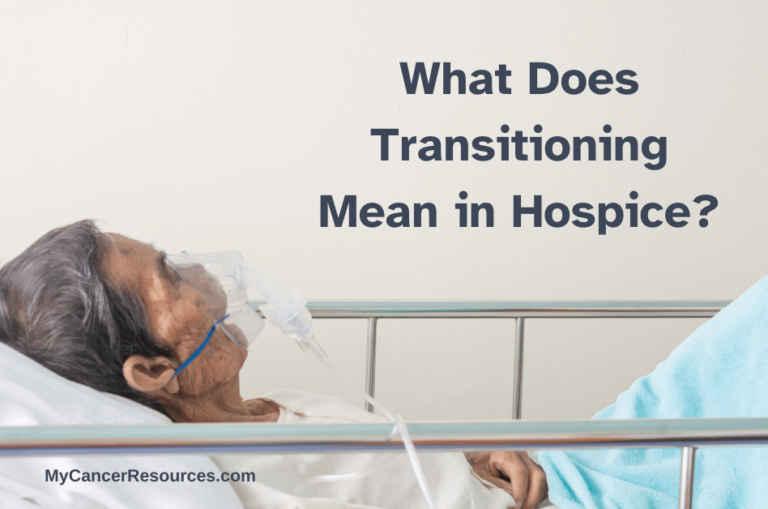
Hospice care is a type of compassionate care for people with terminal cancer or other terminal diseases. The focus is on improving the quality of life in the last days of life. Our culture tends to shy away from the topic of death and dying, and so most of us don’t understand the dying process or the terms used for this stage of life. A question I get fairly often is “What does transitioning mean in hospice care?”
I’m happy whenever I have the opportunity to talk about palliative care and hospice options with my clients.
Not because I am morbid, but because I have seen firsthand the many ways that the services provided by a palliative care team or hospice team can make both the person with cancer and their family members feel comfortable, heard, and supported.
Hospice uses an interdisciplinary care team to care for the physical, emotional, and spiritual needs of the dying person and family caregivers.
The team includes a doctor, hospice nurse, social workers, chaplains and nursing assistants that all work together to care for the patient through the end of their life.
We used hospice care when my mother in law learned there were no more curative treatment options for her cancer. She was officially given a terminal diagnosis, and our focus switched to making sure she was comfortable and was able to live out her final days as she wanted to.
What Does Transitioning Mean in Hospice Care?
One word that was confusing to both my mother-in-law and other family members was transitioning. They wanted to know: What does transitioning mean in hospice?
Transitioning is the phrase used when the body begins its natural process towards the end of life. The transition (moving from one stage of life to another) marks the change from active living to the body’s preparation for death.
Transitioning can occur over days or weeks. Some signs that transitioning is happening are increased sleepiness, changes in eating and drinking habits, and a gradual withdrawal from socializing.
The body is shutting down, and the person may sleep more. It doesn’t mean that death will happen immediately, but rather the body will continue to slow down. Transitioning is an early indicator of the hospice patient’s final stages of life.
Recognizing the beginning of the final stage of life helps caregivers and families to make sure the patient’s final wishes are being followed and that their remaining time is lived with dignity and comfort by receiving the best possible care.
Recognizing the Signs of Transition
By paying close attention to patterns of the person with the terminal illness, caregivers and families can recognize when transition is beginning.
Physical signs often start before the transition. Patients may not be as responsive as they once were. Physical movement may become too difficult, so they prefer staying in bed and sleeping more often.
There may be a drop in blood pressure, and the hands and feet may become cool to the touch. Their skin tone may begin to change as well.
Appetite typically decreases during transitioning, because the body does not need much food or water at this stage. Metabolic changes are happening in their body, and since they’re not using much energy by moving around, they don’t need as much food or drink to keep their body going.
Emotionally, individuals might display signs of restlessness or agitation.
They may become more quiet and introspective, or they may become more talkative during the times they are awake, to make sure they’re able to say all the things they want to before dying.
Recognizing these signs of transitioning can help family members reassure their loved one that all of this is normal and to be expected, and that they and the hospice staff will do whatever necessary to keep them comfortable as death approaches. They are experts in the management of these symptoms and know just what to do during the transitioning phase.
Knowing that their final decisions will be respected provides a huge sense of relief and they can rest as their body moves through the different phases of the dying process.
Providing Comfort in the Transition Stage
Providing comfort is critical during the transition stage. The person is not able to control their body temperature very well, so soft blankets that can be layered or removed as needed are recommended to keep them comfortable.
If your loved one enjoys and appreciates having lotion rubbed into their skin, you can continue this practice, and use lip balm to keep their lips from cracking.
Offering ice chips when they’re awake (if they can still swallow) can help keep their mouth moist and provide relief. If swallowing is difficult, the hospice program may provide swabs that can be used to moisten the mouth.
Ways to provide emotional support can include active listening when your loved one speaks about the end of their life, their wishes and maybe even regrets. Provide a safe, supportive environment where they can talk about what’s on their mind.
Share memories, look at pictures, or ask questions that you had always wanted to know about but hadn’t asked yet. Memories of these times spent with your loved one may become some of your fondest to look back on.
Remember that comfort doesn’t always require words. Simply sitting nearby in silence can be reassuring to someone receiving end-of-life care.
Some of the best conversations I ever had with my mother-in-law were after she entered hospice care. Though talking openly about her upcoming death was sad, it was important for both of us that I was there and that she felt comfortable opening up and sharing her thoughts, fears and hopes.
Simply sitting and holding their hand or placing your hand gently on their arm can convey comfort and help remind your loved one that you’re there and they’re not alone.
Spiritual support can be provided by arranging for visits from spiritual leaders, playing soothing music that resonates with the patient’s spiritual beliefs, or participating in family rituals that bring solace to the dying person.
Some may have vision-like experiences which can be calming or upsetting. Be sure to listen without judgment and simply support them if they try to describe what they’ve seen.
Transition vs. Active Dying Phase
Transitioning in hospice comes before the active dying phase, which is when the body completes its final work of dying. This phase happens in the final days or hours leading to death and is reviewed in more detail in a different blog post.
During the active dying phase, verbal communication decreases even more, and most of the time the patient is sleeping heavily, possibly in a comatose-like state.
There are times where breathing can become irregular or there can even be short periods of no breathing. This irregular breathing is called Cheyne-Stokes respirations, and can sometimes involve noisy breathing. Despite it being noisy, this is not the ‘death rattle’ that occurs closer to the actual moment of death.
The hands and feet become even cooler and the skin color may change even more.
Skin will often become mottled, looking almost bruised and purplish due to the lack of blood circulation. Internal organs continue to shut down.
Pain relief efforts often need to be stepped up during the transition phase. If the person seems more agitated than usual or if sleep is restless, it may be because they’re in pain, but cannot get comfortable or communicate to their caregivers.
Your healthcare provider can identify the common symptoms of uncontrolled end of life pain and make sure their pain medication is strong enough to keep the pain at bay.
Support for Family Members During Transition
It can be physically, mentally and emotionally draining to be a caregiver to someone transitioning. Remind yourself that this can be a gesture of love and dedication.
Lean on the medical professionals of the hospice team for the practical support and to help you process the emotions of being present at the end of a loved one’s illness.
Transitioning to the Final Farewell
As we navigate the closing chapters of a loved one’s life, it’s important to cherish every moment. Hospice plays a critical role in ensuring comfort and preserving dignity for the individual and making sure the patient’s wishes for the end of life are followed.
The compassionate approach of hospice focuses not on hastening or postponing death, but on alleviating pain and addressing emotional and spiritual needs of the individual. Accepting the cycle of life with grace allows us to offer the dying person the peace they deserve.
One of the most frequent questions of cancer patients entering hospice is ‘what’s going to happen to me?’ And when the word transition is used, the next question is typically, ‘what does transitioning mean in hospice?’ I hope this explanation has provided both people with cancer nearing their end of life and their caregivers some support in being able to understand what transitioning means and what can be expected at this time.
It often gives people great comfort to know what to expect and know what their caregivers might experience during different stages of the hospice experience. That’s my goal in writing these posts as well: to remove the stigma of thinking about and talking about death.
To make death less scary.
I can’t make it less sad, but hopefully I can help remind terminally ill patients and their caregivers that they’re not alone. I am here to provide support, answers and resources, just like your hospice health care team is.
Your turn: what other words or phrases related to end-of-life care, hospice and dying would you like to learn about? Let me know in the comments below if this sort of definition and explanation has been helpful.



